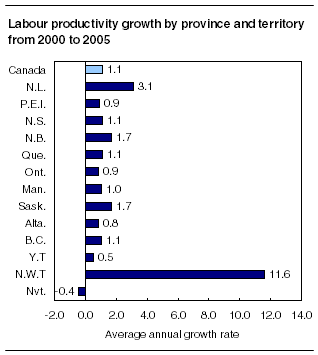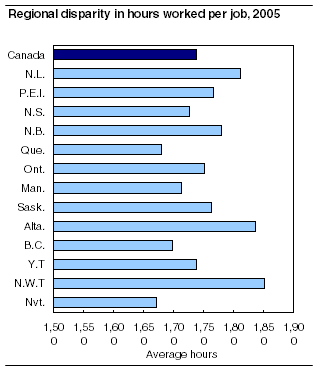Common menu bar links
Hours worked and labour productivity in the provinces and territories
Archived Content
Information identified as archived is provided for reference, research or recordkeeping purposes. It is not subject to the Government of Canada Web Standards and has not been altered or updated since it was archived. Please "contact us" to request a format other than those available.

Over the 2000 to 2005 period, Alberta and Nunavut experienced the strongest growth in hours worked, while the Northwest Territories and Newfoundland and Labrador registered the highest gains in labour productivity.

Construction industry has propelled growth in hours worked since 2000
Hours worked in Canada grew on average by 1.5% annually from 2000 to 2005, due in part to large increases in the construction and retail trade industries as well as the finance and insurance sectors. These industries alone accounted for 44% of the growth in hours worked, equal to the creation of some 120,000 jobs annually. Over the same period, the national average annual growth of labour productivity in the economy as a whole was 1.1%.
Note to readersThis release reviews average annual increases in hours worked and labour productivity at the national, provincial and territorial levels from 2000 to 2005. Labour productivity measures are usually limited to the business sector. However, in this provincial and territorial analysis, productivity measures cover the overall economy, including the rent for owner's occupied dwellings. Productivity estimates in this report were based on the Fisher chained real gross domestic product (GDP) at market prices because a provincial measure of real GDP for the business sector is not available at present. Economic performance as measured by labour productivity must be interpreted carefully, since these estimates reflect changes in other inputs (particularly capital) in addition to the growth in productive efficiency. Labour productivity growth is often affected by changes in industrial structure over time. This update of labour statistics is consistent with the revised provincial and territorial economic accounts for 2005 that were released in The Daily on November 8, but also includes revisions to hours worked estimates for the 1997 to 2005 period to incorporate the Labour Force Survey revisions published in January 2006. |
Construction ranked first in terms of growth in hours worked in Alberta, British Columbia and Prince Edward Island, as well as the Yukon. It placed second in Ontario and Newfoundland and Labrador, and third in Nova Scotia and Quebec.
Retail trade was the prime contributor to the growth in hours worked in Newfoundland and Labrador and Quebec, whereas it stood second in New Brunswick and the three Prairie provinces and third in Ontario and the Yukon.
Three other industries, administrative and support services; professional, scientific and technical services; and health care and social assistance, also experienced substantial growth in hours worked over the period. They added over 127 million hours per year on average, equivalent to 76,000 jobs annually, to the Canadian work force.
Growth in hours worked in Ontario, New Brunswick and Manitoba was primarily due to gains in administrative and support services. This industry ranked second in Prince Edward Island, Nova Scotia and British Columbia.
At the other end of the scale, agriculture continued its downward trend with an average loss exceeding 8,000 jobs per year, a figure which translates into nearly 18 million hours. Losses were particularly severe in Prince Edward Island and in the three Prairies provinces.
The food and apparel industries also lost ground and were down over 20 million hours of work or over 4,000 jobs per year. This decrease was concentrated in Quebec and Ontario. Apparel outpaced all others in terms of lost hours. Aircraft manufacturing has lost nearly 16,000 jobs since 2001.
Alberta leads all other regions in terms of annual hours of work per job
In 2005, the two regions with the highest annual level of hours per job were the Northwest Territories (1,852 hours) and Alberta (1,836 hours). In contrast, the two regions where hours worked per job were the lowest were in Quebec (1,680 hours) and British Columbia (1,699 hours).

From 2000 to 2005, Alberta experienced the largest increase in total hours worked with an annual average rate of 2.5%. In fact, Alberta is the only province where annual hours worked per job grew over this period.
All of the other provinces and two territories experienced a decrease in average hours worked over the same period, with the largest decline in the Northwest Territories (-1.2%) while there was no change in the Yukon.
Second only to the Northwest Territories, Quebec saw its average hours worked fall by 0.7% annually from 2000 to 2005. However, whereas Northwest Territories work patterns drew closer to the Canadian average, Quebec figures showed a drift in the opposite direction.
All provinces have shown productivity gains on average since 2000
At the national level, labour productivity in the total economy grew on average by 1.1% per year over the 2000 to 2005 period. During this period, the growth rate in real gross domestic product averaged 2.6%, while the growth in hours worked averaged 1.5%.
Since the start of the decade, labour productivity increased on average in all provinces, with the fastest growth in Newfoundland and Labrador. Saskatchewan and New Brunswick also posted average annual growth rates above the national average.
Nova Scotia, Quebec and British Columbia enjoyed a growth rate at par with the national average.
Manitoba, Ontario, Prince Edward Island and Alberta trailed the national average.
Labour productivity jumped 11.6% in the Northwest Territories as diamond mines in the region were brought into production. Productivity growth was more modest in the Yukon (+0.5%) and declined in Nunavut (-0.4%).
Newfoundland and Labrador takes the lead as oil production come on stream
Over the past six years, the productivity levels of Newfoundland and Labrador outpaced that of all the other provinces, mostly due to the coming on stream of offshore oil production. The launch of this new, highly capital-intensive industry has transformed the province's industrial structure. Labour productivity in Newfoundland and Labrador grew at the yearly average rate of 3.1% from 2000 to 2005.
Available on CANSIM: tables 383-0009 and 383-0010.
Definitions, data sources and methods: survey number 5103.
For more information, or to enquire about the concepts, methods or data quality, contact Jean-Pierre Maynard (613-951-3654; fax: 613-951-3292; productivity@statcan.gc.ca), Microeconomic Analysis Division.


 Table(s).
Table(s).